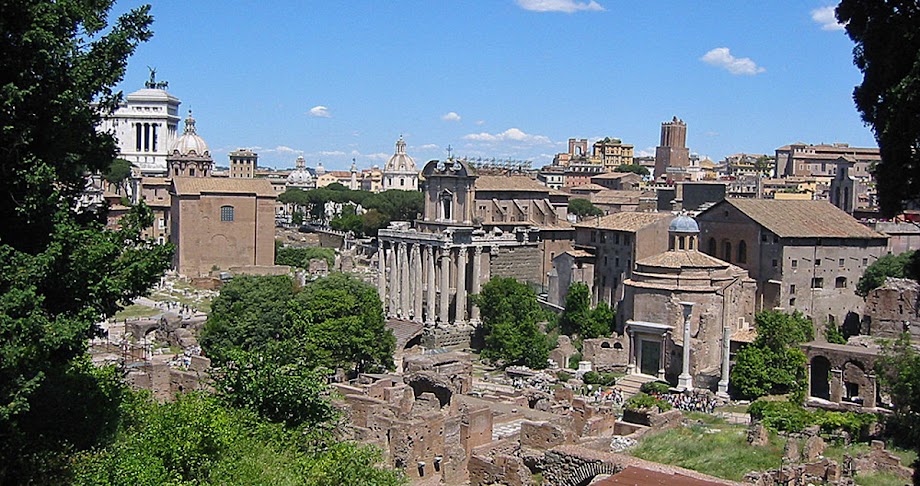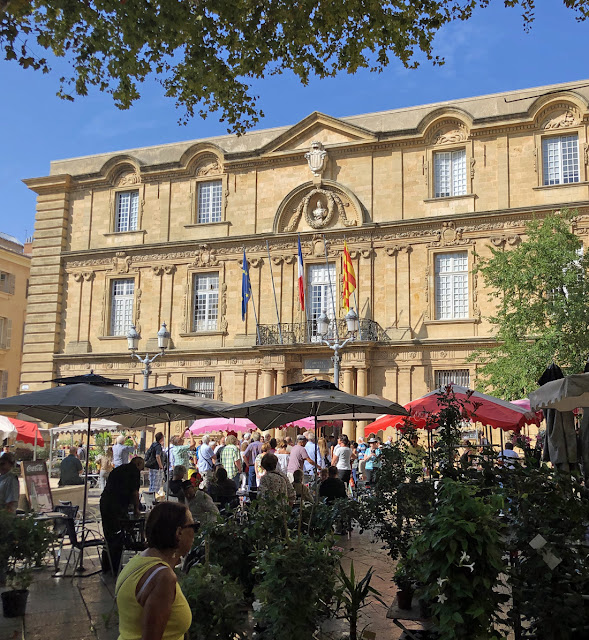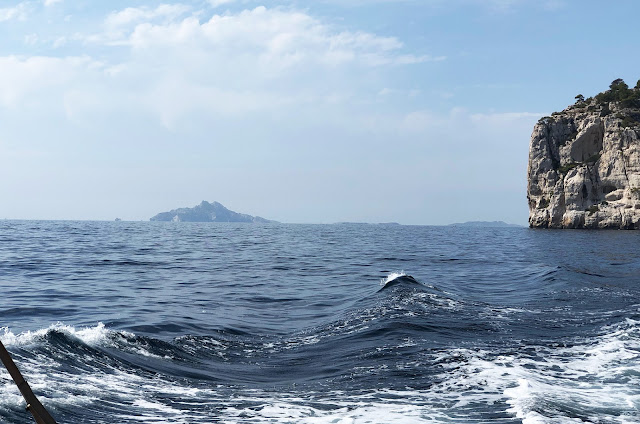Before I launch into days three and four, allow me an aside to explain why I was so excited to visit Marseille.
Aside: I can do it in two words: Marcel Pagnol. Novelist, playwright, film director (the first movie director to be inducted into the Académie Française), he wrote three closely interrelated plays in the late 1920s: Marius, Fanny, and Cesar, about common people who lived in and worked around the Vieux Port. In 1929 he met film director Alexander Korda and suggested the first of these plays might make a good film. Korda agreed and, with Pagnol as screenwriter, directed Marius, which became one of the first successful "talking" motion pictures in France. Pagnol also wrote the screenplay for Fanny, and he wrote and directed Cesar. The three became known as the Marseillaise trilogy.
Briefly, Cesar owns a waterfront bar, his son Marius waits tables there. Marius longs to go to sea, but he also is in love with Fanny, who along with her mother sells fish on the waterfront. She is also very much in love with Marius. Will he embrace the sea, or marry Fanny? The rest of the story is far too complicated to relate, but please read on:
Fast-forward to 1961. Joshua Logan directed a version of Fanny that starred Leslie Caron (with whom I am deeply in love, in fantasia land) along Horst Buchholz, Maurice Chevalier and Charles Boyer. I have lost count of the many times I watched that film, but I promise you that I was reduced to tears with each viewing. Caron's performance is heart-wrenching, and the music by Harold Rome will break your already wrenched heart.
Marius wanted to go to sea, I wanted to go to Marseille to breathe in the sea and and sigh for Leslie C. At age 72 I finally got the chance. I couldn't get the love theme from Rome's score (which swells and swells with every bittersweet moment in the film) out of my mind throughout my stay..
So! Aside complete, on day three of my Marseille stay I looked up the hill above the city to see an iconic image of the city and the film:
Notre Dame de la Garde, literally "guarding" the city and its denizens. I was determined to visit the church, and fortunately there's a teeny tourist train that shuttles people back and forth - only a few yards from where I took the above photo.
The church was built in the mid-to-late 19th century, and while its exterior is dramatic, its interior is stunning - above the altar area, below, a close-up of the space above the altar.
As in other cities I've been to that are dependent in part on the sea for their survival, boats are portrayed, painted into the area above the virgin in the above photo, with models hung in groups of five from the rafters, as you see below. If you look closely to the right, you'll another single boat hanging as well.
There are several of these groups of boats throughout the church. The connection between Marseille and the sea is strong.
The views from outside the church are impressive. Above the view towards Cassis, below the city spread.
On the way back down I caught another view of Notre Dame de la Garde. She's always watching, guarding her city.
Once down at the port again I had time before my second major event of the day, so I
wandered, stopping in at the Marseille football (soccer, know what I mean?) store, looking for a souvenir for my soccer-crazed nephew...I was drawn again to Norman Foster's crazy mirror. I took several photos from different angles - this is my favorite, wonderfully symmetrical, to my mind.
And I asked a woman selling fish if she had a daughter named Fanny...she was not amused.
At last, my second big adventure of the day. Another boat rip, this time to the place, if you can believe Alexandre Dumas, where Edmond Dantes was imprisoned, before he miraculously escaped and became The Count of Monte Cristo - the Chateau d'If.
So, off to If...
Out we sailed, a boatload - and it was loaded, not a seat to be had for a person who might arrive moments before sailing - through the harbor,
passing as we did the hip museum called Mucem (above) that I would visit on the following day. I love the long black walkway over the water to the museum
then the two castles, one on each side of the waterway (above and below) that once upon a time had guarded the city
And after a short, pleasant voyage, we arrived at the island/prison,
the colorful Mediterranean splashing up to the rocky shore
and the fearsome prison itself. "Abandon all hope, ye who enter here..."
As I did not wish to abandon hope, I did not enter the prison. Instead I opted for a cocktail very popular among the citizens of Marseille,
called a pastis, flavored with anise. It was my first glass, and almost assuredly my last glass ever - not my cuppa. But for people who like that sort of thing...that is the sort of thing they like.And my outdoor table afforded me a great view back to Marseille.
I boarded the next available boat back the mainland
As soon as I alit from the boat, I went in search of food! Actually I didn't have to search, because a helpful young woman back at the Lyon tourist bureau had given me a tip as to her favorite place to eat at the Vieux Port...
And she was not wrong, in fact I later emailed her to thank for the suggestion.
the interior was light and airy
And the member of the waitstaff who served me was excellent. I ordered monkfish - ugly looking fish, but really tasty, and wash it down, I thought I'd go local - a glass of cassis. The server paused briefly, then recommended another white that would better accompany the the fish. I was about to accept her judgement without argument when she said, "Wait! I will bring you a small glass of each and you can decide!"
Like the young woman from Lyon who suggested the eatery, my server was not wrong! Delicious - and less expensive than the cassis would have been. I told her the story of how I found the place, she was delighted and told the other staff, and for a little while I felt like more than just an anonymous tourist - a brief encounter. Lovely!
A fine dining experience, a great way to end the day.
******
Alas, my final day in Marseille was nearly a complete wash-out. The rain was never heavy, but persistent, so my hopes of casually wandering the city were dashed. I did, however, manage to get to two museums, Mucem, as planned (and mentioned/pictured above) the small but delightful Musée Regards de Provence, only a few hundred yards away from Mucem, also near the waterfront.
To the latter first: I missed this gem in my research, so when I found it, it came as a happy surprise! Described as a showcase for the arts of Provence, it owns about 900 artworks created in and about Provence.
The first work I saw was a large photograph (above), featuring the Great Chefs of France posed as the those present at the Last Supper.
Just about everything else I viewed on my visit lived up to the tongue-in-cheek, quirky sense of humor I noticed in the chefs' last supper. Above, "Pierre et Gilles, La Biere Paillette" by Florian Ballico - what a way to sell beer! And below two on the subject of vegetables:
What do you see here? The artist sees "Asparagus gone wild."
And this? "Lettucehead" of course!
There are a few older artworks here, sometimes juxtaposed with a more recent piece on a similar theme:
"The Old Port" by Pomerat, painted 1909
And "Poissoniere" by Baboulene (1947) showing another kind of worker at the port, in a very different style.
The general attitude is delightfully irreverent:
"Art eats art!" As to museums themselves?
"Museums 'are not required' or 'serve no useful purpose.'" Nevertheless I had a delightful time in this unique showcase.
I had a long wait at Mucem, because it drizzled the entire time, and there was a very long line, because it was raining and there was little else to do. But it was worth the wait for this "Museum of European and Mediterranean Civilizations."
It is described (in Wikipedia, so take it with a grain of salt) as taking an interdisciplinary approach to the cross-fertilization evident in the history and cultures of the Mediterranean basin. It opened in 2013, to coincide with a year that Marseille was designated the European Capital of Culture.
The lighting in the interior was such that I had a difficult time photographing any of it, so I'll offer a few inscriptions that I hope will give you a sense of the collection, the first historical:
The second offering three very different descriptions of Marseille:
I especially like the third quotation.
Two very different museums, each offering unique and excellent visions on the area in which I was lucky enough to visit.
When I left Mucem it had not stopped raining, so I stopped, as did many others, in at a church on the Vieux Port, the Eglise Saint-Ferreole.
Then savored a delicious "glacier" - as good as gelato, and I love gelato - at a place just next door to it.
I leave you, as I had to leave Marseille (sigh) with a bright announcement of the city and one last look at the Vieux Port and Notre Dame de la Garde. Adieu, Marseille, adieu to anyone who bothers to read this.
Next post from my visit to Arles - and a few great side trips!
















































































